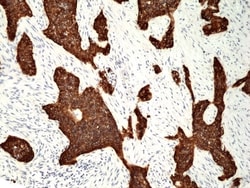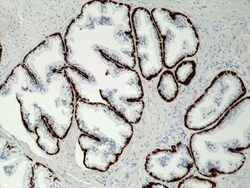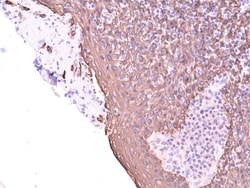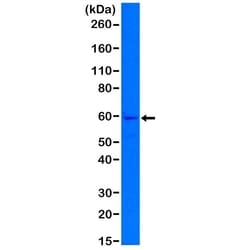Learn More
Invitrogen™ Cytokeratin 5 Recombinant Rabbit Monoclonal Antibody (RM226)
Rabbit Recombinant Monoclonal Antibody
Supplier: Invitrogen™ MA533066
Description
Specificity: reacts to human CK-5 (Cytokeratin 5), and does not cross-react to CK-6 (Cytokeratin 6). Specificity: may also react to bovine, mouse, or rat Cytokeratin, as predicted by immunogen homology. Recombinant rabbit monoclonal antibodies are produced using in vitro expression systems. The expression systems are developed by cloning in the specific antibody DNA sequences from immunoreactive rabbits. Then, individual clones are screened to select the best candidates for production. The advantages of using recombinant rabbit monoclonal antibodies include: better specificity and sensitivity, lot-to-lot consistency, animal origin-free formulations, and broader immunoreactivity to diverse targets due to larger rabbit immune repertoire.
Cytokeratin pan is part of a subfamily of intermediate filament proteins that are characterized by remarkable biochemical diversity, and represented in human epithelial tissues by at least 20 different polypeptides. Cytokeratins range in molecular weight between 40 kDa- 68 kDa, and an isoelectric pH between 4.9-7.8. The individual human cytokeratins are numbered 1 to 20. The various epithelia in the human body usually express cytokeratins which are not only characteristic of the type of epithelium, but also related to the degree of maturation or differentiation within an epithelium. Cytokeratin subtype expression patterns are used to an increasing extent in the distinction of different types of epithelial malignancies. The cytokeratin antibodies are not only of assistance in the differential diagnosis of tumors using immunohistochemistry on tissue sections, but are also a useful tool in cytopathology and flow cytometric assays. The composition of cytokeratin pairs vary with the epithelial cell type, stage of differentiation, cellular growth environment, and disease state. Many studies have shown the usefulness of keratins as markers in cancer research and tumor diagnosis.
Specifications
| Cytokeratin 5 | |
| Recombinant Monoclonal | |
| 0.04 mg/mL | |
| PBS with 1% BSA, 50% glycerol and 0.09% sodium azide | |
| P13647 | |
| KRT5 | |
| A peptide corresponding to the C-terminus of Human Cytokeratin 5. | |
| 100 μL | |
| Primary | |
| Human | |
| Antibody | |
| IgG |
| Immunohistochemistry (Paraffin), Western Blot | |
| RM226 | |
| Unconjugated | |
| KRT5 | |
| 3300001P10Rik; 58 kDa cytokeratin; alpha keratin; AW146334; CK5; CK-5; ckii; ckii protein; cytokeratin 5; cytokeratin-5; DDD; DDD1; EBS2; epidermolysis bullosa simplex 2 Dowling-Meara/Kobner/Weber-Cockayne types; K5; keratin 5; keratin 5 (epidermolysis bullosa simplex Dowling-Meara/Kobner/Weber-Cockayne types); keratin 5 (epidermolysis bullosa simplex, Dowling-Meara/Kobner/Weber-Cockayne types); keratin 5, type II; keratin complex 2, basic, gene 5; keratin type II, tail domain; keratin, type II cytoskeletal 5; keratin, type II cytoskeletal 5; keratin 5; keratin-5; Krt2-5; KRT5; KRT5A; Sak57; Tfip8; tuftelin interacting protein 8; type II alpha-keratin IIA; type II cytokeratin; type-II keratin Kb5; wu:fb02h09; wu:fj02d02; wu:fk78b12; zfCKII | |
| Rabbit | |
| Protein A | |
| RUO | |
| 3852 | |
| -20°C | |
| Liquid |
Your input is important to us. Please complete this form to provide feedback related to the content on this product.



